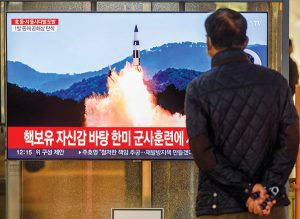Bloomberg
North Korea test-fired a suspected intercontinental ballistic missile with an estimated range long enough to carry a warhead to the American mainland, prompting the US to condemn what it said was an unlawful action.
The North Korean missile was launched Friday, a day after Pyongyang warned the US to halt allied military drills in the region or face retribution. US President Joe Biden was briefed and resolved to bolster security ties with Japan and South Korea, a National Security Council spokesperson said in a statement.
The test came hours after US Vice President Kamala Harris arrived in Bangkok to join the Asia Pacific Economic Cooperation forum. Harris held an impromptu meeting with leaders from Australia, Canada, Japan, New Zealand and South Korea on the sidelines of the event Friday to consult on next steps.
“We strongly condemn these actions, and we again call for North Korea to stop further unlawful, destabilizing acts,†she said at the start of the meeting. “I reaffirmed our ironclad commitment to our Indo-Pacific alliances. Together, the countries represented here will continue to urge North Korea to commit to serious and sustained diplomacy.â€
South Korea’s Joint Chiefs of Staff called the launch a grave provocation and serious threat that harms peace.
The missile flew for more than an hour, reaching an altitude of around 6,000 kilometers (3,730 miles) and a distance of about 1,000 kms, Japanese Defense Minister Yasukazu Hamada told reporters. That gave the missile an implied range of more than 15,000 kms, he said — enough to reach the US.
The flight time and landing site would be consistent with an ICBM fired in a lofted trajectory to avoid passing over international territory. The last time North Korea successfully conducted such a test was in March, when it fired its Hwasong-15 ICBM that reached an altitude of 6,200 km and traveled 1,080 kms to splash down in the sea west of Japan.
The latest test underscored the challenges the Biden administration faces in trying to slow down Kim Jong Un’s atomic ambitions. Kim is finding space to ramp up provocations and conduct tit-for-tat military moves against the US and its allies as Biden focuses on Russia’s war in Ukraine. Russia and China, two long-time partners of North Korea, have veto power at the UN Security Council and have shown no interest in punishing Kim with extra sanctions.
The US, meanwhile, has stepped up joint training with South Korea and Japan in recent months with drills aimed at deterring North Korean military moves at land, sea and in the air. This included a joint missile-defense drill Thursday with South Korea, which coincided with the threat from North Korean Foreign Minister Choe Son Hui of a militarily response if the US keeps up with joint exercises.
“The keener the US is on the ‘bolstered offer of extended deterrence’ to its allies and the more they intensify provocative and bluffing military activities on the Korean Peninsula and in the region, the fiercer the DPRK’s military counteraction will be,†she said in a statement issued by state media, referring to North Korea by its formal name.
China is North Korea’s biggest benefactor and President Xi Jinping has held a series of summits with the US and its allies such as Japan and South Korea during international gatherings over the past few days in Asia. Xi sought cooperation in high-tech manufacturing in a meeting with South Korean President Yoon Suk Yeol as the Biden administration has put in place sweeping curbs on the sale of advanced chips to China.
“In addition to the obvious annoyance with the US, South Korea and Japan, Kim Jong Un is probably not happy with Xi Jinping’s over-friendly summits with Presidents Biden and Yoon,†said John Delury, a professor of Chinese Studies at Yonsei University Graduate School of International Studies in Seoul.
 The Gulf Time Newspaper One of the finest business newspapers in the UAE brought to you by our professional writers and editors.
The Gulf Time Newspaper One of the finest business newspapers in the UAE brought to you by our professional writers and editors.
